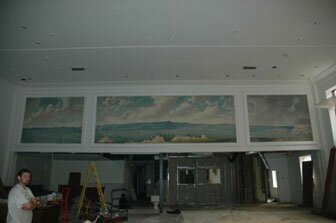ONARCHITECTURE- Picture taking: Bank mural up for grabs
Last week we reported that developer Oliver Kuttner's design crew wanted to save the large painted mural adorning the inside of the old Boxer building on the Mall, which Kutter bought recently and is in the process of renovating. At first, according to construction foreman John Haywood, the idea was to leave it uncovered and simply work around it, a delicate task considering all the interior demolition going on. But now Kuttner and company have decided to have the painting removed.
"We wanted to give it a new home," says Gate Pratt, one of the architects working with Kuttner on the project. "And it looks like we might have a taker." Pratt says the owners of another commercial property on the Mall with a big lobby have expressed interest, but he declined to say who until they've formally accepted. In the meantime, Pratt says that anyone else interested in the mural, which Kuttner is willing to part with for free, is welcome to ask for it.
The 50-foot long, 10-foot high mural, divided in three sections, offers a sweeping pastoral image of the Blue Ridge Mountains, a view of Monticello from Montalto, and the City of Charlottesville beyond the tree line. It was painted by H. Warren Billings in 1955, according to his signature on the painting. And according to an accompanying plaque, it was commissioned and offered as a gift to Citizens Bank and Trust by Mrs. Inez Duff Bishop. But when Pratt tried to find out more about the painting and the artist, he came up empty-handed.
"Obviously, it doesn't belong in the Louvre," he says, "but I thought there might be some general interest in the painting and the artist."
Pratt called Jean Collier at the University of Virginia Art Museum, who managed to track down Billings' son, a professor of history at the University of New Orleans.
"I know the mural of which you speak quite well because I helped the artist, my father, hang it," Warren M. Billings wrote in an e-mail to Collier. "It was one of many he painted during his career. Dad died 20 years ago at the age of 92. It's nice to hear that it still hangs in the bank."
Later, Pratt contacted the younger Billings to let him know the painting was going to be moved.
"As you perhaps have discovered," Billings wrote, offering more details about its application to help in its removal, "the mural is painted on canvas. Dad painted it in his studio in Richmond, then rolled it up, carted it off to Charlottesville, and hung it using a high grade of wallpaper paste... I can say that it was wheat-based because I can still recall its dough-like smell.
"Once the mural was in place, Dad touched it up as necessary and blended the edges in with the surrounding wall. When everything was well dry, he gave the mural a wash of thinned buttermilk, which he said served to tone down any sharp highlights that could catch the sun."
Pratt is also hoping to locate an art conservator with the knowledge and skill to remove the painting and place it elsewhere without damaging it. "It's not as easy as grabbing it and yanking it off the wall," he says.
During the search for Billings, Pratt also stumbled upon some unique history about the building when he contacted local archaeologist Ben Ford. For instance, he learned that the eastern half of the building (the building was originally two buildings before the bank renovation) was the original home of Woolworth's, which opened in the early 1920s and was there for nearly 40 years.
Home to a bookstore and frame shop in the late 19th and early 20th centuries, the corner lot the old Boxer building occupies was sold to Citizens Bank and Trust in 1930. Although no photos of the bank built on the spot in 1931 survive, an old article in the Daily Progress hailed it as a futuristic wonder.
"Its brick, concrete and limestone construction is pieced together in remarkable simplicity," the Progress reported of the new structure. "On the front are unique floodlights. One enters the building through modernistic aluminum sliding doors to step on a floor of terrazzo blocked off with brass strips.... The architecture was explained in detail by Elmer E. Burruss, who incidentally stated he believes the modernistic design set forth in the building will eventually dominate American construction. ...The entire design is one of magnificent simplicity."
Apparently, it was also the only bank in the United States to be opened at the height of the Great Depression in 1931.
It wasn't until 1965 that Citizens Bank and Trust (later Central Fidelity) bought the former Woolworth's space, expanded the interior, and built a new façade designed by architect Joseph C. Laramore Jr. (Architectural records also show that the two paintings on either side of Billings' signed central piece didn't go up until after the bank expanded the building.)
The new façade– made of marble, ceramic, and glass, and heralded as a modern "classic" by the Progress at the time– was an effort to blend the two buildings into one.
Forty years later, Kuttner and architects Pratt and David Kariel will attempt to unblend the two buildings and then blend them back together. Might the local press heap as much praise on Kuttner and company's new design as they did on the building's previous incarnations? Stay tuned.

Kuttner and Co. think they've found a home for this mural from the old Boxer building, but it's not quite a done deal.
PHOTO BY DAVE MCNAIR

"We wanted to give it a new home," says architect Gate Pratt of the mural in the old Boxer building. "And it looks like we might have a taker."
PHOTO BY DAVE MCNAIR
#